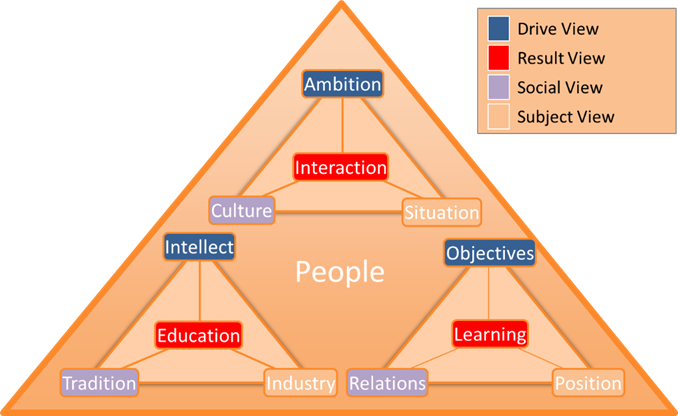
Summary
The purpose of the People Dimension is to assess how the change is impacted by different behaviour and to identify some of the most important roles in the team.
We may all be from the same species, but that is where the commonalities end. We all have different personalities; we think, feel and behave differently. We are humans, meaning that we are full of individual qualities and flaws. Each of the more than 7 billion people on this planet are different and we must deal with these differences and individual personalities every day.
The Transformation Team
If you want to win in the market, you will need a best-in-class Transformation Team. The team will need the right mindset, qualifications and the right experience which gives the right behaviour. In other words, you will not see a substandard team win a championship title. It will require a combined effort stemming from synergy among the various elements.
You will have to assess which competence is needed to win the battles. The competences needed will change over time, depending on the Planning Dimension Activity and the Process Dimension Discipline. Gauge the competences needed now and anticipate those that will be needed in the future.
Recruit the brightest minds of the organisation if the competences are not available internally; do not hesitate to recruit externally. Intelligence supersedes experience and the ability to extract knowledge from abstract information supersedes factual business knowledge. The objective is to change the rules of the game anyway, so being stuck with habitual thinking is a disadvantage. Look for people who are dynamic, intelligent, motivated and have the right attitude to lead the change.
Perspectives in the People Dimension
The objective of the People Dimension is to provide an understanding of how the individual will be able to thrive and deliver value to the organisation in a transformed business. As a part of the journey, it is important for the Transformation Organisation, when creating the change plan, to incorporate activities in the transition plan that will ease the adoption of the new working paradigm in the organisation.
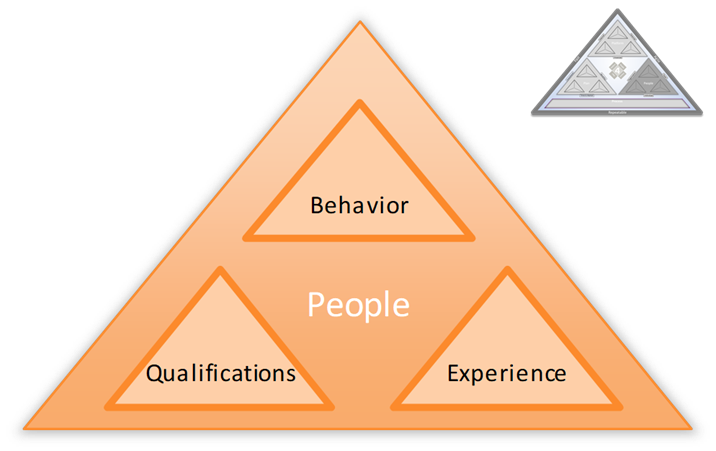
Behaviour Perspective
The understanding of behaviour is used here as the behaviour at the work place. The outcome of how an individual behaves is the reaction from the surroundings when the individual with a specific behaviour starts to interact. Work behaviour is very often related to the profession (think about the differences between a lawyer and a computer geek).
Qualification Perspective
The Qualification Perspective relates to the fundamental competences. What is the mental capacity and the social heritage and the education?
Experience Perspective
Throughout our career we will learn new things each day. We learn a lot from success and even more from our failures! Our leaning is dependent of the positions we have had and the working conditions in the industry.
Themes in the Behaviour Perspective
Many factors guide what we do. Here, the focus is only on what we do at work.
To lead individuals, it is important to be familiar with the individuals’ behaviour in a restricted environment, as well as outside the business premises. A lot of team-building concepts try to account for this.
Psychometric testing analyses people’s behaviour in given situations. The test can be used to assess how an individual would interact with others in specific roles.
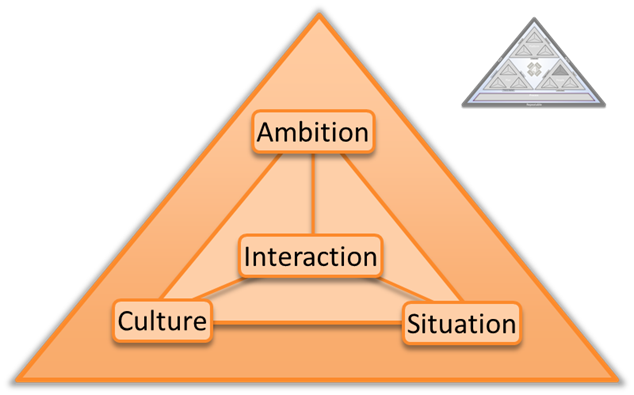
Ambition Theme
Ambitions are the personal drivers for motivation and passion.
| Ambition is a powerful desire to achieve objectives. |
Ambitions (or fears) are some of the most important fundamentals in an individual’s motivation to support or antagonize change. For the management of change, it is crucial to be aware of each participant in the change ambition. People are either with the change or against it!
Fear is the other side of ambition. An individual is also motivated to escape fears in that occurs in realising ambitions.
Interaction Theme
When you are building a high-performance transformation team, it is important that the participants can inspire and challenge each other. If the members cannot interact with each other, it will be very difficult to create synergy between even the best competences. And it will require diverse competences to solve unfamiliar and complex challenges in a digital transformation.
| The interaction is how an individual relates and communicates with others in a specific work-oriented situation. |
Culture Theme
Here, culture is used in the sense of corporate culture.
| Culture refers to the beliefs and behaviours that determine how a transformation team member interact with each other to create and promote a result. |
Corporate culture will be the common denominator for how individuals should behave in the organization, team or group. There must be an understanding of sense of urgency and a necessity for change. At the same time, it should be commonly acceptable to fail and learn from others.
A specific cultural task is to establish a team spirit and a mutual understanding, that no individual can succeed on their own! And of course, no success – if change fails! Strong, high-performance teams tend to create their own culture within the group. It will require good leadership competences to stimulate the creation of such a sub-culture.
Situation Theme
All behaviour of an individual is dependent on the situation in which the individual is setting themselves! Behaviour can be caused by other team members, the management, the customers, the industry and even the individual’s private life. These factors impact work behaviour in one way or another.
| The situations are the daily incidents where an individual will have to react on external input. |
It is a competence to react proactive, positive, rational and accommodating in critical situations.
Themes in the Qualification Perspective
The Qualification Perspective describes the individual’s basic capacity based on the formal knowledge that the individual possesses.
However, hardly any individuals possess all the competencies needed for succeeding with a change. The winning team has been built and the required staff must be sourced in – either from the Production Organisation or from the outside.
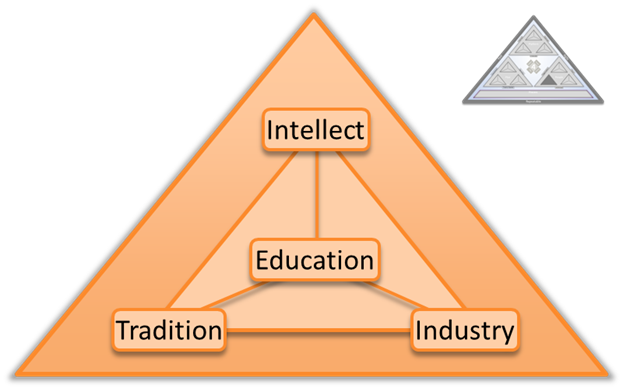
Intellect Theme
The Intellect Theme describes the capacity for rational and intelligent thoughts of the individual. This is the raw machinery of the brain that can process factual information.
A high intellectual capacity is the foundation for high performance, but if there is a lack of knowledge, learning, ambition or appropriate behaviour, the performance may deteriorate.
| The Intellect is the individual’s mental ability to solve problems. |
Education Theme
The education theme is the formal, general training that an individual has received. This can be in school, university or in different courses and certifications. The education and training should match the need of the new, changed organization. As a part of the Transition Theme of the Plan Dimension, it should be evaluated whether individuals will match the future needs of the business or if they could be trained to undertake new tasks.
| The education is the individual’s formal learning in schools, universities and training programs. |
Tradition Theme
Tradition is the mindset of habitual thinking. We are used to doing things in a certain manner. These patterns are imposed on us from childhood and we react according to those traditions in the country, society, family or social network without thinking about whether it is the right thing to do in each situation. Also, old organizations with a frozen management hierarchy in stable business environments may build up so strong traditions that innovation and change is bound to fail.
| The Tradition is the behaviour imposed by the culture in the society or the subculture of an ethnic group. |
Much of the tradition originates from the culture and society in which an individual grew up and presently lives. These traditions form the basic values of the individual.
Industry theme
The Industry Theme relates to the industry in which the company conducts its business. In any business, there will be Subject Matter Experts who have an in-depth understanding of the territory in which the business operates. Having the right insight into challenges in the industry, as well as the themes of the Platform Dimension’s Perspectives, will be crucial for a successful business transformation.
| Industrial knowledge is the individuals understanding of an industry’s business environment with its customer, technology, legislation and rules. |
Themes in the Experience Perspective
There may be many passionate and highly motivated people in the organization, but all the positive energy must be used to provide value for the business and its customers. The objective of the Experience Perspective is to use the staff’s experience for a maximum-value sprint according to the organisation’s objectives.
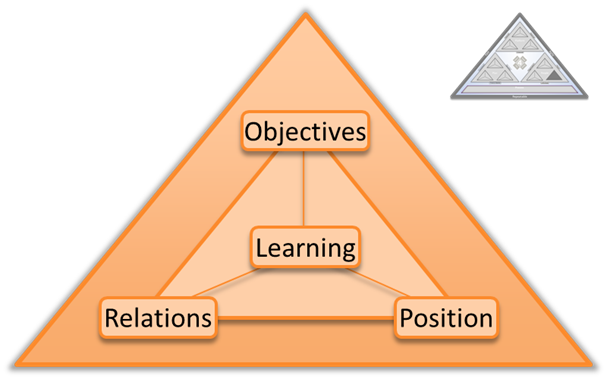
Objectives Theme
In their daily work, people seek to fulfil the objectives related to their positions.
| An objective is a goal which an individual must achieve. |
In relation to change, the objectives are related to the scope of the change, work packages in the Planning Dimension and the capabilities to be delivered. To get the Transformation Organisation to execute, it is important to get buy-in for the objectives from the participants in the change. This buy-in is very closely related to the ambitions of the individual.
Learning Theme
This theme is about individuals learning throughout the career, in different organisation and positions. Organizational learning is accumulated in the execution of the themes in the Operation Dimension and learning about the change execution is accumulated in the themes of the Plan Dimension and documented in the updated work package descriptions.
| Learning is the accumulated knowledge on what to do and not to do based on previous experience. |
Individuals learn from success as well as failure. Sometimes, learning from failure is more valuable to accumulate, because the business may try to fix the same failure again after it has occurred the first time.
Relations Theme
As jobs become more complex and require many more skills, the individual’s personal network becomes more important. Where do individuals get their inspiration? Would there be a friend to call both inside and outside the organization when a difficult problem needs to be solved?
| The relations let the individual access other’s competences when executing a job. |
The postulate is that well-connected people will have access to more experience, and that the collective knowledge base is much larger than the individuals. Well-connected people with profound social competences is very valuable for facilitating change.
Position Theme
The last the theme in the Experience Perspective is to create a position in the change where the individual can excel. When designing a business transformation or a change, it should be assessed which individual will match the roles in the processes based on their competencies and ability to succeed.
| The position is roles placement in the organisational hierarchy with a precise description of the duties and responsibilities related to the role. |
Views on the People Dimension
Like the Platform and Planning Dimensions, the themes are divided into 4 classes of competences; the simple views.
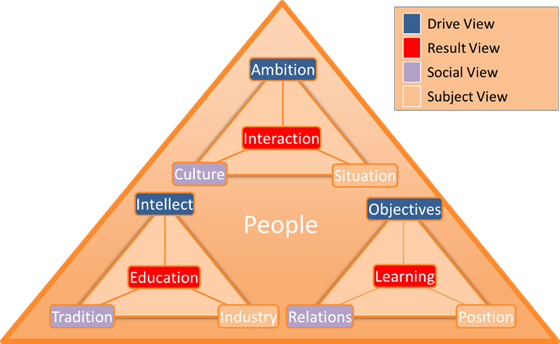
Drive View
The People Dimension is fuelled by individual ambitions, the objectives for the individual and the education. This view defines the value that the individual can produce in the organization.
Result View
Results are achieved by the individual’s education, performance and right behaviour. This represents the factual outcome of the individual’s effort.
Social View
The Social View gives the individual guidance in how to handle different situations. It is composed of traditions, learning from previous situations, and the culture of the organization.
Subject View
The Subject view encompasses the firm structures of the ecosystem. The industry, subject, position and situation all define the environment in which the individual would need to operate. The staff with the deepest insight into the subject view themes are called Subject Matter Experts.
Controls on the People Dimension
High motivation by the participants in a Change Process is crucial for the success of the change.
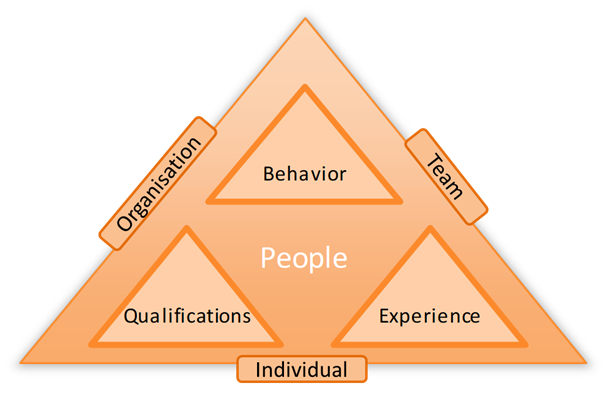
The 4Dimensions™ Transformation Framework works with 3 controls of motivational factors:
- Factors related to the Organisation’s mission and vision, its position in society, its brand, and its corporate values
- Factors related to the Team, department or group in which the individual is working. It is very much about the psychological working environment, for example, mutual relations, appraisals and status among peers
- Factors related to the Individual: Ask the question: “What is in it for me?” It could be career opportunities, reputation with family or friends, learnings, bonuses and salary.
Approaches to The People Dimension
The management can choose different approaches for managing people. The approaches reflect the different leadership styles that would be most applicable.
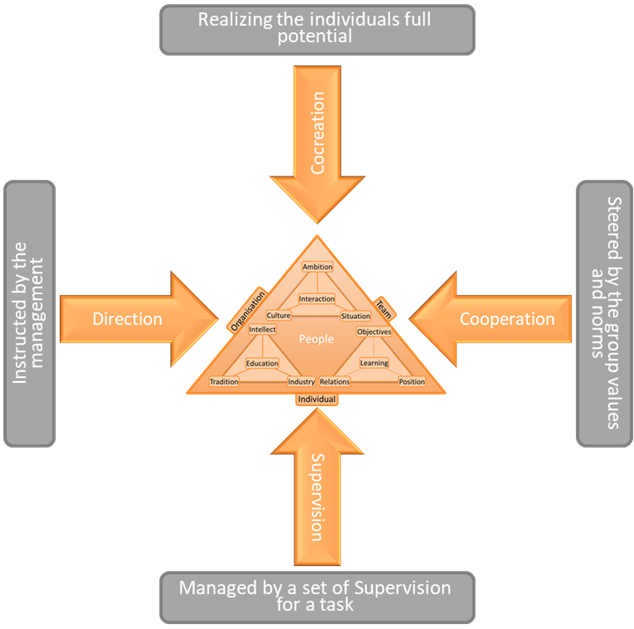
The Cocreation Approach
Self-Actualisation is one of the key philosophies of motivation. The individual is assumed to be self-motivating. This is based on McGregor’s Theory X and Y, where it is assumed that the individual is self-motivated. Many grassroots organizations are based on self-motivated people realising their ambitions through personal and mutual coordinated initiatives.
In the Cocreation Approach, it is very difficult to establish a common solution because everyone follows their own mind and will create their own kind of solution. It requires excellent leadership skills to use this approach.
The Cooperation Approach
Scandinavian cultures are known for their short distance of power. Decisions are made in plenum and are based on consensus and mutual adjustment. In this setup, all participants should feel that they have influence on the decisions made. Influence provides a strong path to motivation. It is also difficult to get buy-in by the participants if there is no influence.
The final solution in the Cooperation Approach may be unambitious, because it may be the minimal set of issues the group can agree on. Because the lack of consensus, it may have a negative impact on some of the participants performance – and certainly it will slow the transformation.
The Supervision Approach (MBO)
Management by Objectives is the most common approach to managing people. Everyone will be assigned a set of performance measures which are a breakdown of Controls from all the dimensions. In most instances, the employee is punished in terms of salary, benefits and career progression if the targets are not met.
In common terms, this management type is also referred to as Management by Excel, because all information is collected in Excel sheets and all decisions are based on the numbers.
The problem with this approach is the strong focus on what can be measured by a few Controls. Controls must be constructed to cover all situations, and unpredicted situations are difficult to fit into the approach.
The Direction Approach
The power to give other instructions and orders is one of the most commonly used approaches. Here a manager micromanages the individual’s work. With a disciplined staff, decisions can be implemented fast and efficiently. There will probably not be very much buy-in, but if the Directions are clear, the staff is relieved of the responsibility for the quality of the decision. If things go wrong, it is the manager’s problem.
However, the Direction Approach becomes difficult when the manager is not a Subject Matter Expert. The quality of the decision can often be poor if Subject Matter Experts are not involved and given influence.
Using different People Approaches
Just as we saw it with the approaches to the Planning and Platform Dimension, the approaches on top to the right requires a more strategic understanding and creative a mindset. The approaches in the bottom and to the left will use a more practical and execution focused mindset.
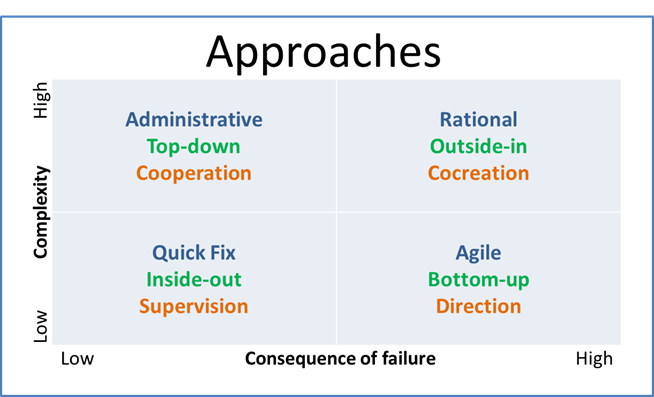
The relation between the approaches stresses the need for a coherent transformation framework. You will have to work in Platform, Planning and People Dimensions at the same time. As you will see in that Process Dimension will tie these three dimensions together.
© 2018 4dimensions.info
